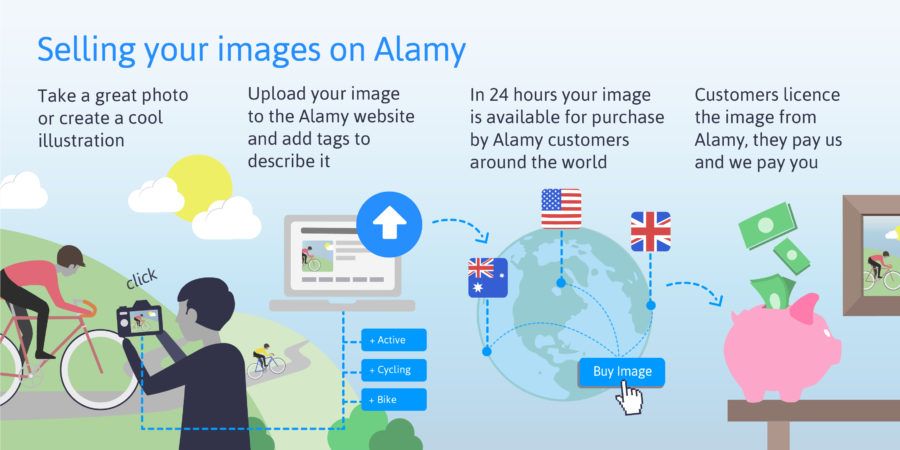1. Introduction:
Alamy is a well-established and widely recognized stock photography platform that offers photographers the opportunity to sell their images to a global audience. With its extensive reach and large customer base, many photographers are drawn to Alamy as a potential avenue for monetizing their work. However, before diving into the world of stock photography, it's important to evaluate the effectiveness of Alamy as a platform for selling photos.This blogpost aims to provide a comprehensive assessment of Alamy's strengths, weaknesses, and overall effectiveness in helping photographers generate income. By delving into factors such as licensing options, image discoverability, contributor support, and success stories, photographers can make an informed decision about whether Alamy is the right platform for their photography business.Also Read This: What Does Alamy Mean by Vectors? A Guide to Vector Licensing
2. Is Alamy Good for Selling Photos?
 Alamy can be a good platform for selling photos, but its effectiveness depends on various factors. Here are some key points to consider:1. Wide Reach and Market Presence: Alamy has a global customer base and a strong reputation in the stock photography industry. This provides an opportunity for photographers to reach a broad audience of potential buyers.2. Licensing Options and Pricing: Alamy offers a range of licensing options, including royalty-free and rights-managed licenses. The platform also provides competitive pricing, allowing photographers to set their own prices and earn a fair royalty.3. Image Discoverability and Searchability: Alamy employs a robust search algorithm that considers various factors like metadata, keywords, and categorization. Properly optimizing these elements can improve the visibility and searchability of your photos on the platform.4. Submission Process and Approval: Alamy's submission process is relatively straightforward, and the platform provides guidelines to help ensure your images meet their quality standards. However, image approval can be subjective, and not all submissions may be accepted.5. Contributor Support and Community: Alamy offers support to photographers through resources, forums, and a community of fellow contributors. This can be beneficial for networking, learning, and getting assistance when needed.6. Success Stories and Testimonials: Many photographers have found success on Alamy, with some earning significant income from their image sales. Success stories and testimonials can provide inspiration and insight into the platform's potential.However, it's important to note that results may vary for individual photographers. Success on Alamy depends on factors like the quality of your images, market demand, competition, and your marketing efforts outside the platform. It's crucial to assess your own goals, photography style, and target market to determine if Alamy aligns with your objectives.
Alamy can be a good platform for selling photos, but its effectiveness depends on various factors. Here are some key points to consider:1. Wide Reach and Market Presence: Alamy has a global customer base and a strong reputation in the stock photography industry. This provides an opportunity for photographers to reach a broad audience of potential buyers.2. Licensing Options and Pricing: Alamy offers a range of licensing options, including royalty-free and rights-managed licenses. The platform also provides competitive pricing, allowing photographers to set their own prices and earn a fair royalty.3. Image Discoverability and Searchability: Alamy employs a robust search algorithm that considers various factors like metadata, keywords, and categorization. Properly optimizing these elements can improve the visibility and searchability of your photos on the platform.4. Submission Process and Approval: Alamy's submission process is relatively straightforward, and the platform provides guidelines to help ensure your images meet their quality standards. However, image approval can be subjective, and not all submissions may be accepted.5. Contributor Support and Community: Alamy offers support to photographers through resources, forums, and a community of fellow contributors. This can be beneficial for networking, learning, and getting assistance when needed.6. Success Stories and Testimonials: Many photographers have found success on Alamy, with some earning significant income from their image sales. Success stories and testimonials can provide inspiration and insight into the platform's potential.However, it's important to note that results may vary for individual photographers. Success on Alamy depends on factors like the quality of your images, market demand, competition, and your marketing efforts outside the platform. It's crucial to assess your own goals, photography style, and target market to determine if Alamy aligns with your objectives.Also Read This: Assessing the Safety of Using 123RF for Your Creative Projects
3. Alamy's Reach and Market Presence
Alamy boasts an impressive reach and market presence in the stock photography industry. Here are key points to consider:1. Global Customer Base: Alamy has a vast international customer base consisting of individuals, businesses, media organizations, and creative professionals. This wide audience increases the potential for your photos to reach a diverse range of buyers.2. Established Reputation: Alamy has been operating since 1999 and has established itself as a reputable and reliable platform for purchasing high-quality images. Its longevity in the industry lends credibility to the platform and attracts buyers seeking professional content.3. Industry Partnerships: Alamy has partnered with major global organizations, including media companies, publishers, and advertising agencies. These partnerships provide additional opportunities for photographers to have their images licensed for various commercial uses.4. Distribution Network: Alamy has a network of distribution partners that extends its reach even further. This means that your photos have the potential to be licensed and used in a wide array of contexts through Alamy's distribution channels.5. Market Share: While specific market share data is not publicly available, Alamy is recognized as one of the leading stock photography platforms. Its sizeable collection of diverse and high-quality images contributes to its influence in the industry.Alamy's reach and market presence offer photographers the potential to gain exposure to a global audience and attract buyers from various sectors. However, it's important to combine this reach with effective marketing strategies and high-quality content to maximize your chances of success on the platform.If you are a photographer, you can make money selling your photos online; Instead of the photos staying on your device useless. One of the most popular sites where you can sell photos is: Alamy https://t.co/bXVz4Sar5C Shutterstock https://t.co/E4lqzZrPxp pic.twitter.com/QtQGWbXRtZ
— YOUCEF NB (@AtLwmat) April 20, 2022
Also Read This: Should You Provide Both Vertical and Horizontal Photos on Alamy
4. Pros and Cons of Alamy:
| Pros | Cons |
|---|---|
| Large library of images | Fierce competition |
| Global reach | Low commission rates |
| Variety of licensing options | High fees for using Alamy's marketing tools |
| Easy to use interface | Can be difficult to get your images noticed |
| Competitive pricing |
- Your target market: If you are targeting a specific audience, you may want to consider other stock photo agencies that have a larger following in that niche.
- Your budget: Alamy's commission rates are relatively low, but you may want to factor in the cost of using its marketing tools when making your decision.
- Your time commitment: If you are not able to promote your images actively, you may have a harder time making sales on Alamy.
Also Read This: Which 123RF Features Help You Find the Perfect Free Stock Images for Your Brand?
5. Licensing Options and Pricing
Alamy offers photographers a variety of licensing options and pricing models for selling their photos. Here's an overview of the key licensing options and how pricing works on the platform:1. Royalty-Free (RF) License: - The Royalty-Free license grants the buyer the right to use the image multiple times without any additional fees after the initial purchase. - The photographer sets the price for each image based on Alamy's pricing guidelines. - The royalty rate for photographers starts at 50% of the sale price and increases based on the photographer's lifetime earnings on Alamy.2. Rights-Managed (RM) License: - The Rights-Managed license provides more control over the usage of the image. - Photographers set specific usage restrictions and negotiate a price with the buyer based on the intended use of the image. - The royalty rate for RM licenses is typically higher than RF licenses, and photographers can negotiate higher fees for exclusive usage.3. Novel Use: - Alamy offers a "Novel Use" option where images can be sold at a lower price for specific uses, such as for personal or educational purposes. - The royalty rate for Novel Use licenses is lower than standard RF licenses.4. Editorial Use: - Alamy allows photographers to sell editorial images that capture newsworthy events or have an editorial context. - Editorial images can be licensed for specific editorial purposes, and the pricing is based on factors like the image's relevance and uniqueness.5. Alamy Distribution Sales: - Alamy's distribution network allows images to be made available to multiple partners and customers around the world. - The pricing for distribution sales may vary, and the photographer's royalty is calculated based on the sale price and distribution partner's agreement.It's essential for photographers to consider their target market, image quality, and licensing preferences when setting prices and choosing licensing options. Alamy's flexible pricing models and licensing choices allow photographers to cater to various clients and maximize their earnings based on the usage and value of their images.The following video is about how to make money on Alamy:Also Read This: 123RF vs Getty Images: Comparing Two Leading Stock Photography Platforms
6. Submission and Approval Process
Submitting your photos to Alamy involves a straightforward process, but approval is subject to certain criteria. Here's an overview of the submission and approval process on Alamy:1. Create an Account: Start by creating an account on the Alamy website as a contributor. Provide the necessary information and agree to the terms and conditions.2. Image Upload: Once your account is set up, you can upload your photos through the Alamy Contributor Dashboard. Organize your images into batches and upload them using the provided upload tool or FTP (File Transfer Protocol) option.3. Metadata and Keywording: Each image requires accurate and descriptive metadata, including titles, descriptions, and relevant keywords. This information helps potential buyers find your photos when searching on Alamy.4. Quality Control: Alamy has quality control measures in place to maintain a high standard for the images available on the platform. Your uploaded photos will go through a review process to ensure they meet Alamy's technical and content requirements.5. Approval and Rejection: Alamy's team of reviewers will assess your images based on technical aspects like focus, exposure, and noise, as well as content suitability. They may reject images that don't meet the quality standards or violate Alamy's guidelines. Rejected images can be revised and resubmitted.6. Review Time: The review time can vary but is typically within a few days. During peak periods, it may take longer. You can track the status of your submissions through the Contributor Dashboard.It's important to carefully review Alamy's guidelines for image submission, including requirements for image quality, model releases, and acceptable content. Adhering to these guidelines increases your chances of having your images approved for sale on the platform.Remember that the review process is subjective, and it's possible for some images to be rejected even if you believe they meet the criteria. Continuous improvement in your photography skills and understanding Alamy's content standards will help increase your acceptance rate and the quality of your portfolio on the platform.Also Read This: How to Download Alamy Photos for Free Without Watermarks
FAQs for evaluating Alamy's effectiveness for selling photos:
1. Is Alamy a good platform for selling photos?Answer: Alamy is a well-established stock photo agency with a large library of images. It offers a variety of licensing options and has a global reach. However, the competition on Alamy is fierce, and it can be difficult to make a significant amount of money selling photos on the platform.2. What are the pros and cons of selling photos on Alamy?Pros:- Large library of images
- Global reach
- Variety of licensing options
- Easy to use interface
- Competitive pricing
- Fierce competition
- Low commission rates
- High fees for using Alamy's marketing tools
- Can be difficult to get your images noticed
- The quality of your images
- The popularity of your images
- The licensing options you choose
- The amount of marketing you do
- Create an account
- Upload your images
- Add keywords and descriptions to your images
- Choose your licensing options
- Start promoting your images
- Using Alamy's marketing tools
- Sharing your images on social media
- Networking with other photographers
- Attending industry events

 admin
admin








